
Newport News Shipbuilding (NNS), a division of Huntington Ingalls Industries, is the sole designer, builder, and refueler of aircraft carriers and one of two providers of submarines for the United States Navy. Founded as the Chesapeake Dry Dock and Construction Co. in 1886, Newport News Shipbuilding has built more than 800 ships, including both naval and commercial ships. Located in the city of Newport News, Virginia, its facilities span more than 550 acres (2.2 km2).

The Nimitz class is a class of ten nuclear-powered aircraft carriers in service with the United States Navy. The lead ship of the class is named after World War II United States Pacific Fleet commander Fleet Admiral Chester W. Nimitz, who was the last living U.S. Navy officer to hold the rank. With an overall length of 1,092 ft (333 m) and a full-load displacement of over 100,000 long tons (100,000 t), the Nimitz-class ships were the largest warships built and in service until USS Gerald R. Ford entered the fleet in 2017.

USS Enterprise (CVN-65), formerly CVA(N)-65, is a decommissioned United States Navy aircraft carrier. In 1958, she was the first nuclear-powered aircraft carrier and the eighth United States naval vessel to bear the name. Like her predecessor of World War II fame, she is nicknamed "Big E". At 1,123 feet (342 m), she is the longest naval vessel ever built and the only ship of a class that was originally planned to have five other ships. Her 93,284-long-ton (94,781 t) displacement ranks her class as the third largest carrier class, after the Nimitz class and the Gerald R. Ford class. Enterprise had a crew of some 4,600 service members.

USS George Washington (CVN-73) is a United States Navy nuclear-powered aircraft carrier, the sixth carrier in the Nimitz class and the fourth US Navy ship named after George Washington, Founding Father, commander-in-chief of the Continental Army during the American Revolutionary War, and the first president of the United States. The contract for George Washington was awarded to Newport News Shipbuilding on 27 December 1982. Her keel was laid on 25 August 1986, she was christened on 21 July 1990 by First Lady Barbara Bush, and the vessel was commissioned at Naval Station Norfolk on 4 July 1992.

USS Gerald R. Ford (CVN-78) is an aircraft carrier for the United States Navy and the lead ship of her class. The ship is named after the 38th President of the United States, Gerald Ford, whose World War II naval service included combat duty aboard the light aircraft carrier Monterey in the Pacific Theater.
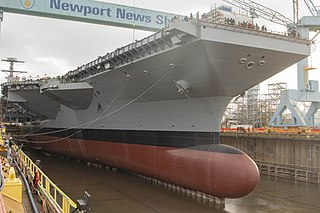
USS John F. Kennedy (CVN-79) is the second Gerald R. Ford-class aircraft carrier built for the United States Navy. She was launched on 29 October 2019, and christened on 7 December 2019.

John Collins Harvey Jr. is a former United States Navy four-star admiral who last served as the 31st Commander, United States Fleet Forces Command from July 24, 2009 to September 14, 2012. He previously served as Director, Navy Staff (N09B) from March 24, 2008 to July 23, 2009. Prior to that, he served as the 54th Chief of Naval Personnel and Deputy Chief of Naval Operations (N1) from November 2005 to April 2008. He retired from the navy after more than 39 years of service.
In the United States Navy, Refueling and Overhaul (ROH) refers to a lengthy refitting process or procedure performed on nuclear-powered naval ships, which involves replacement of expended nuclear fuel with new fuel and a general maintenance fix-up, renovation, and often modernization of the entire ship. In theory, such process could simply involve only refueling or only an overhaul, but in practice, nuclear refueling is always combined with an overhaul. An ROH usually takes one to two years for submarines and up to almost three years for an aircraft carrier, performed at a naval shipyard. Time periods between ROHs on a ship have varied historically from about 5–20 years (for submarines) to up to 25 years (for Nimitz-class aircraft carriers). For modern submarines and aircraft carriers, ROHs are typically carried out about midway through their operating lifespan. There are also shorter maintenance fix-ups called availabilities for ships periodically at shipyards. A particularly lengthy refueling, maintenance, and modernization process for a nuclear aircraft carrier can last up to almost three years and be referred to as a Refueling and Complex Overhaul (RCOH).

Thomas John Kilcline Jr. is a retired vice admiral of the United States Navy who served as Commander, Naval Air Forces from June 22, 2007, to July 1, 2010.

The Naval Sea Systems Command (NAVSEA) is the largest of the United States Navy's five "systems commands," or materiel organizations. From a physical perspective, NAVSEA has four shipyards for shipbuilding, conversion, and repair, ten "warfare centers", the NAVSEA headquarters, located at the Washington Navy Yard, in Washington D.C., and other locations in 15 states and 3 overseas continents.

Huntington Ingalls Industries, Inc. (HII) is the largest military shipbuilding company in the United States as well as a provider of professional services to partners in government and industry. HII, ranked No. 375 on the Fortune 500, was formed on 31 March 2011, as a divestiture from Northrop Grumman.
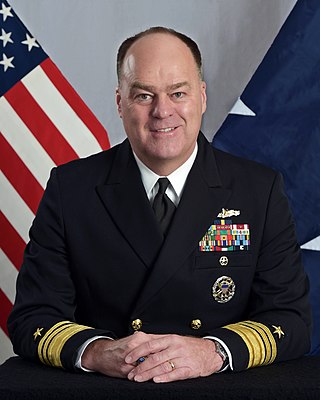
John Nels Christenson is a retired vice admiral in the United States Navy who last served as the United States Military Representative to the NATO Military Committee, in Brussels, Belgium. He was the 53rd President of the Naval War College in Newport, Rhode Island from March 2011 to July 2013.

James Edward Service was a vice admiral of the United States Navy active during much of the Cold War. A naval aviator, he flew combat missions in the Korean War and Vietnam War, commanded aviation units and various ships including aircraft carriers, served as a test pilot, and was President of the Naval War College.

USS Enterprise (CVN-80) will be the third Gerald R. Ford-class aircraft carrier to be built for the United States Navy. She will be the ninth United States naval vessel and third aircraft carrier to bear the name, and is scheduled to be in operation by 2028. Her construction began in August 2017 with a steel-cutting ceremony.

Vice Adm. Phillip Monroe Balisle a native of Idabel, Oklahoma, was commissioned in the United States Navy in 1970 after graduating from Oklahoma State University. At sea, he commanded the destroyer USS Kidd (DDG-993), the cruiser USS Anzio (CG-68) and the USS Abraham Lincoln (CVN-72) Battle Group. He served as Director, Surface Warfare Division on the Chief of Naval Operations staff at the Pentagon.
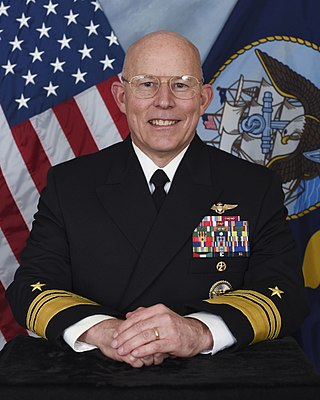
DeWolfe H. "Chip" Miller III is a former vice admiral in the United States Navy who retired as the Commander, Naval Air Forces, which is also Type Commander (TYCOM) for all United States Navy aviation units, and dual-hatted as Commander, Naval Air Force, Pacific.

USS Doris Miller (CVN-81) will be the fourth Gerald R. Ford-class aircraft carrier of the United States Navy. Doris Miller is scheduled to be laid down January 2026, launched October 2029 and commissioned in 2032. She will be built at Newport News Shipbuilding, a division of Huntington Ingalls Industries in Newport News, Virginia.

William Rhode Merz is a retired United States Navy vice admiral who last served as deputy chief of naval operations for operations, plans and strategy from August 6, 2021 to October 7, 2022. He previously served as commander of U. S. Seventh Fleet from 2019 to 2021.
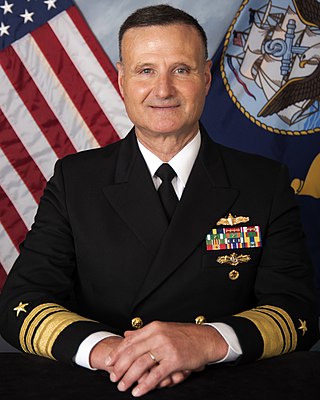
Vice Admiral William J. Galinis is a retired United States Navy officer and career Engineering Duty Officer who served as the 45th Commander of Naval Sea Systems Command from June 2020 to September 2023.
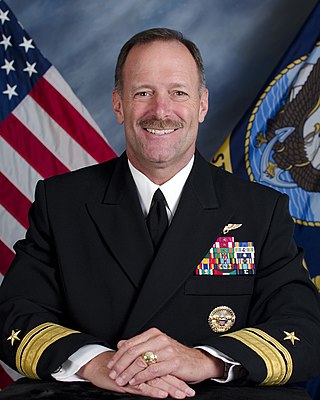
Michael Charles Manazir, also known as Rear Admiral Mike Manazir, is a retired United States Navy two-star admiral who transitioned to civilian life from duty as the deputy chief of naval operations for warfare systems on July 7, 2017.



















